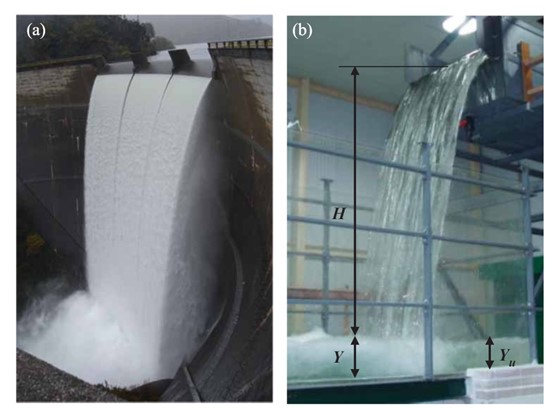Hello, my name is Siemen Algra, and I am in the final year of the Master’s program Hydraulic and Offshore Structures at the TU Delft. I’m fascinated by hydropower and large dams, which is why I have chosen this area for my master’s thesis research.
In the Netherlands, not much research is conducted in this area due to a practical reason—the lack of altitude differences in our flat country. This, combined with my love for travel, made me look for opportunities abroad, which is how I ended up in the hydraulic engineering laboratory at the University of Liege. The lab conducts extensive academic research on hydraulic structures, such as dams and hydropower plants, and offers physical modeling services to a wide range of clients, ranging from public administration to private companies in the hydraulics sector.

My research focuses on flow solicitation in plunge pools downstream of free-fall spillways. Spillways are used to evacuate excess inflow discharges from the reservoir to the downstream river. This prevents overtopping at the dam’s crest, which is typically prohibited. Additionally, during extreme events, hydropower plants are often closed, making the spillway the sole route for water evacuation.
Different types of spillways exist; as mentioned earlier my research focuses on the free fall spillway combined with a plunge pool, a configuration used in practice. The free fall is initiated close to the crest of the dam and can take the form of a jet, as seen at the Kariba Dam, or of a nappe—a rectangular, very wide jet—the latter is the primary focus of the research. The nappe, originating from a short free overflow weir, freely falls through the air, potentially dropping up to 100 meters. During this descent, the nappe’s high potential energy transforms into kinetic energy. Due to the interaction between the nappe and the surrounding air, turbulence occurs at the outer edges, causing air to be entrained—making the flow multiphase—and some energy to be dissipated. Then, the high-energy nappe impinges in the plunge pool, where turbulence is again generated due to the velocity gradient between the nappe and the water in the pool. When the plunge ends, the (leftover) nappe impacts on the plunge pool bottom, exerting pressures, which can potentially cause damage.
Being able to predict these pressure characteristics is crucial for designing structures that can withstand them. In practice, this can be done with the use of models. In this research, we use physical scale models. Measurements are taken on these models, and the results are extrapolated to prototype scale. This can be done by using appropriate scale factors or by making the measured parameters dimensionless; i.e. parameters independent of the model’s dimensions, making them directly applicable to prototype scale. However, achieving full similitude between the prototype and scale model is not possible due to the intrinsic nature of gravity driven flows and difficulties with, for example, the scaling of fluid properties and gravity. This introduces so-called scale effects. These scale effects are the results of the inability to achieve full similitude and thus the cause of differences between the conditions on the scale model and the prototype. An example of these scale effects is the huge air-entrainment in prototype flows, resulting in the white-foamy appearance of flow on the prototype, which is more limited on the scale model, as can be seen in the picture below.

Differences shown between a prototype with a fall height of a 100 meters and a scale model of it with a fall height of 1.70-3.00 meters. (Luis G. Castillo, José M. Carrillo & Antonio Blázquez, 2015)
Since, to the best of my knowledge, no prototype data exists to directly assess the influences of scale effects on plunge pool pressures, I will conduct measurements on a model of the same prototype at two different scales to investigate whether and how scale effects influence dimensionless pressure parameters. This study aims to pave the way for developing a scaling relationship. Such a relationship, derived from measurements performed on a variety of scales, would enable predictions on one scale based on measurements done on another. My research would contribute to improve the ability to extrapolate model data and thus to enable better design for better hydraulic structures.
